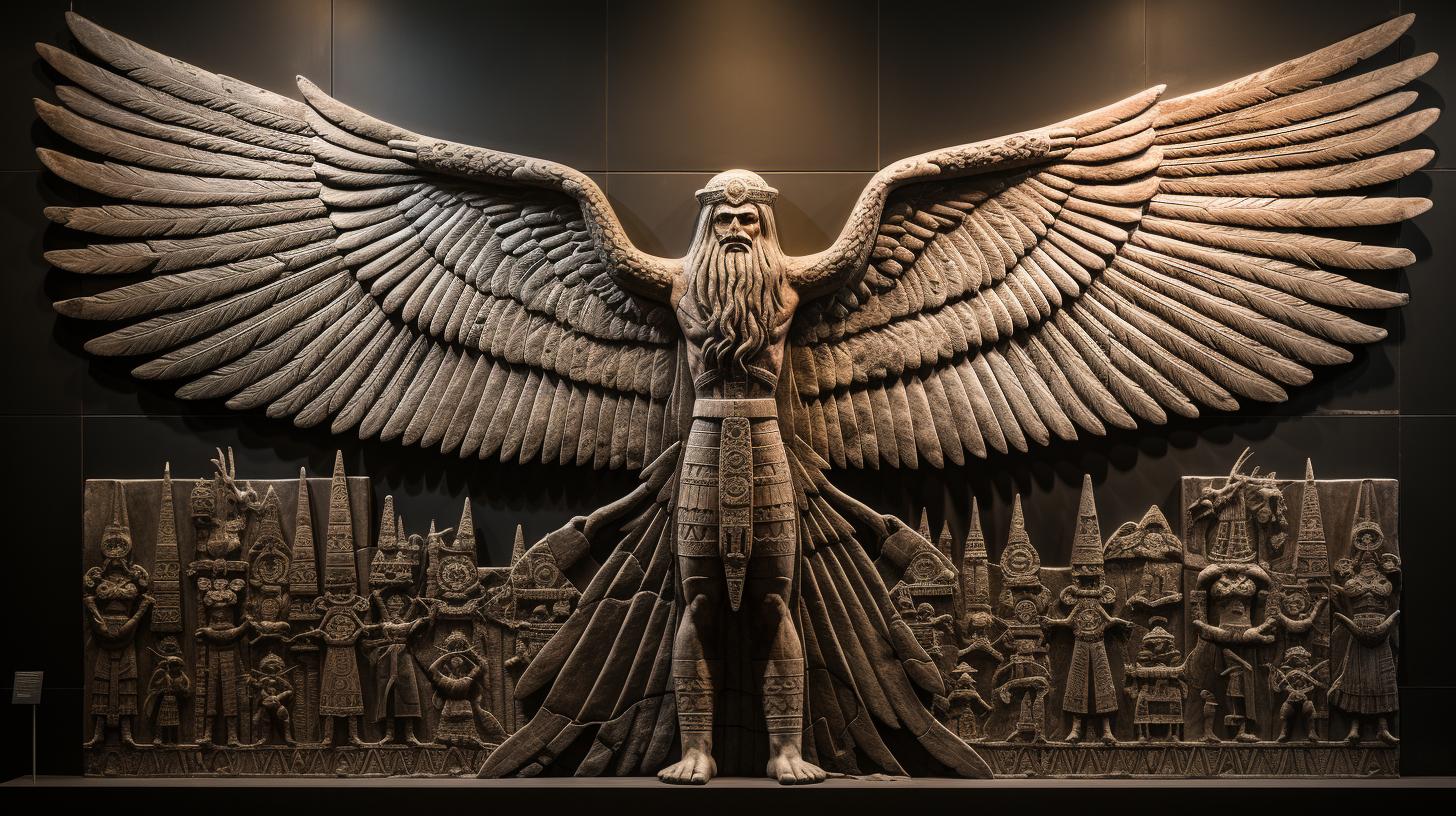Sarpanit Goddess: The Mesopotamian Deity and Her Powerful Role in Ancient Babylon

The Sarpanit Goddess holds a prominent place in Mesopotamian mythology and religion. She is revered as the wife of Marduk, the mighty god of Babylon. Sarpanit’s associations include pregnancy and motherhood, while her role as a queen elevated her to a high-ranking deity.
Worship of Sarpanit thrived in Zarpan and Babylon, with various spellings and epithets attributed to her. Her connections extend to other deities such as Ea and her son Nabu. Exploring Sarpanit’s significance sheds light on ancient Near Eastern beliefs and practices, leaving a lasting legacy in Mesopotamian religion.
The Sarpanit Goddess: An Overview
Welcome to our exploration of the enigmatic Sarpanit Goddess. In this section, we will provide a comprehensive overview of this captivating deity from Mesopotamian mythology. Delving into her history, role, and significance, we aim to shed light on the intriguing world of Sarpanit worship.
Join us as we unravel the mysteries surrounding Sarpanit, starting with her origins and the legends that surround her. You will discover her integral connection as the wife of the powerful deity Marduk, and the role she played in the Mesopotamian pantheon as the Queen of Gods.
We will also delve into Sarpanit’s associations with pregnancy and motherhood, highlighting her significance as a maternal figure within the ancient Babylonian culture. Additionally, we will explore her worshippers and sacred sites, including her cults in Zarpan and Babylon.
Furthermore, we will examine the different names and epithets associated with Sarpanit, revealing the various ways she was referenced and revered throughout history. Our journey will also uncover the goddess’s relationships with other deities, such as her ties to Marduk and her renowned role as the mother of Nabu.
Be prepared to immerse yourself in the captivating world of Sarpanit, as we unveil her role in Babylonian mythology and religious practices.
From creation myths to her worship rituals and symbolic representations, we will explore how Sarpanit shaped the ancient Near East.
Ultimately, our exploration will touch upon Sarpanit’s lasting legacy and her continued influence on later deities and goddesses.
Engage with us as we deep dive into the mesmerizing realm of the Sarpanit Goddess, enriching our understanding of Mesopotamian religion along the way.
The History and Origins of Sarpanit
Historical records suggest that Sarpanit’s worship dates back to ancient times, with evidence of her veneration found in texts and artifacts. While the exact origins of Sarpanit remain somewhat elusive, she is prominently known as the wife of Marduk, the powerful god of Babylon.
Their union bestowed upon Sarpanit a significant role in the religious and mythological traditions of Mesopotamia.
Sarpanit’s influence extended beyond her marital ties, as she was also associated with various aspects of life.
She was believed to possess authority over fertility, particularly in relation to pregnancy and motherhood. As such, she was revered for her role in bringing forth new life and nurturing the next generation.
Throughout history, Sarpanit’s significance grew, and she was eventually regarded as a queen and a high-ranking deity. Epithets such as ‘dama,’ ‘reina,’ and ‘queen of Babylon’ were bestowed upon her, highlighting her elevated status among the gods.
The worship of Sarpanit was widespread, with dedicated cult centers in Zarpan and Babylon. These sacred sites served as focal points for her devotees, who sought her blessings and protection. The rituals and practices associated with Sarpanit’s worship varied, with offerings and prayers being made to honor her divine presence.
Understanding the history and origins of Sarpanit provides a foundation for comprehending her enduring influence and significance in ancient Mesopotamian culture. Her status as a revered goddess highlights the emphasis placed on female deities and their essential roles within the religious framework of the time.
The Role and Significance of Sarpanit in Mesopotamian Mythology
Sarpanit played a crucial role in Mesopotamian mythology, holding great significance within the pantheon of gods and goddesses. Let’s explore her various aspects that showcase her power and influence.
Sarpanit as the Wife of Marduk
Sarpanit held the esteemed position of being the wife of Marduk, the chief deity of Babylon.
As his consort, Sarpanit was not just a symbolic figure but an integral part of Marduk’s divine authority. This association solidified her status within the hierarchy of deities, emphasizing her importance as a divine queen.
Sarpanit’s Associations with Pregnancy and Motherhood
A significant aspect of Sarpanit’s identity was her connection to pregnancy and motherhood. She was revered as a maternal figure, embodying the nurturing and life-giving qualities associated with childbirth. This aspect of her character brought comfort to worshippers seeking fertility and protection during the birthing process.
Sarpanit’s Status as a Queen and High-Ranking Deity
Beyond her role as Marduk’s wife, Sarpanit held her own position of power and authority within the pantheon. She was acknowledged as a queen, ruling alongside Marduk and sharing a similar status as the ruler of the gods.
This elevated her to a high-ranking deity, commanding respect and adoration from her followers.
In conclusion, Sarpanit’s role in Mesopotamian mythology was multi-faceted. As Marduk’s wife, she contributed to his divine kingship and held remarkable prominence as a queen and high-ranking deity in her own right.
Additionally, her associations with pregnancy and motherhood emphasized her nurturing nature and solidified her place in the hearts of worshippers.
Sarpanit’s Worshippers and Sacred Sites
The worship of Sarpanit, the revered goddess, was widely practiced in various regions of ancient Mesopotamia. Her cult had significant importance in both Zarpan and Babylon, where dedicated sites were established for her worship.
Sarpanit’s Cult in Zarpan
Zarpan, a village near Babylon, served as a prominent center for Sarpanit’s cult. The inhabitants of Zarpan held great reverence for the goddess and conducted rituals and ceremonies in her honor.
Temples and sanctuaries were constructed in Zarpan to house Sarpanit’s statues and conduct worship. Her followers sought her blessings and invoked her for fertility, protection, and prosperity.
Sarpanit’s Cult in Babylon
Babylon, the magnificent city of Mesopotamia, was home to another significant center of Sarpanit’s worship.
The Babylonians held Sarpanit in high regard and built grand temples dedicated to her. These temples, such as Esagil, served as pilgrimage sites where devotees came to offer prayers, sacrifices, and seek the goddess’s favor.
Sarpanit’s cult in Babylon attracted a large number of worshippers, including priests, royalty, and common people, who believed in her powers and sought her assistance in various aspects of their lives.
In conclusion, Sarpanit’s worshippers thrived in Zarpan and Babylon, where her cults were established with great devotion and reverence. Both cities had dedicated sites, such as temples and sanctuaries, where followers performed rituals and sought the blessings of the powerful goddess.
Sarpanit’s Name and Epithets
Sarpanit, the revered Mesopotamian goddess, was known by different spellings of her name. One commonly used cuneiform script rendition was “dzar-pa-ni-tum,” but various Romanizations like Ṣarpānītu were also utilized. It should be noted that some scholars argue that cuneiform writing did not differentiate between the sounds “z” and “ṣ.”
Sarpanit’s various epithets and titles showcased her esteemed status. As the wife of Marduk, she held the titles of “Lady,” “Queen,” “Lady of Babilonia,” “Queen of Babilonia,” “Lady of Esagil,” and “Queen of Esagil.”
Some representations portrayed Sarpanit as a counterpart to Marduk, with similar attributes and a parallel position among the pantheon as the queen of the gods.
The Different Spellings of Sarpanit’s Name
Sarpanit’s name was written in different ways in ancient texts. The most common spelling in cuneiform was “dzar-pa-ni-tum.” However, other Romanized spellings, like Ṣarpānītu, were also used. Linguistic debate exists regarding the distinction between the sounds “z” and “ṣ” in cuneiform script.
Epithets and Titles of Sarpanit
Sarpanit held several revered epithets and titles due to her association with Marduk and her prominent role in ancient Babylonian society. She was referred to as the “Lady,” “Queen,” “Lady of Babilonia,” “Queen of Babilonia,” “Lady of Esagil,” and “Queen of Esagil.”
These titles showcased her elevated status as a high-ranking deity and exemplified her importance within the pantheon.
Sarpanit’s Relationships with Other Deities
In the vast and intricate landscape of Mesopotamian mythology, Sarpanit, the revered goddess, had intricate connections with various deities. These relationships shed light on her significance and role within the divine hierarchy of that ancient world.
Sarpanit’s Connection to Marduk and Ea
Sarpanit’s most prominent relationship was with Marduk, the powerful god of Babylon and her husband. As Marduk’s wife, she held a position of high honor and authority. Additionally, Sarpanit was considered a daughter-in-law of sorts to Ea, another significant Mesopotamian god.
Sarpanit as the Mother of Nabu
Evidence suggests that Nabu, the god associated with writing and wisdom, was believed to be the son of Sarpanit and Marduk. This familial connection elevated her status even further, making her a respected mother figure within the pantheon.
Other Deities Associated with Sarpanit
Besides her central connections, Sarpanit had associations with other deities as well. Two notable figures were Ṣilluš-ṭāb and Katunna, known as the hairdressers of Sarpanit. Additionally, the guardian of the Uridimmu gate held a peculiar connection to her.
Sarpanit in Babylonian Mythology and Religious Practices
Understanding the role of Sarpanit in Babylonian mythology and religious practices gives us insights into the beliefs and rituals of ancient Mesopotamia.
Sarpanit’s Role in Creation Myths
Sarpanit is often depicted in Babylonian creation myths as a key figure in the formation of the world. She is believed to have played a significant role alongside href=”https://oldworldgods.com/mesopotamian/marduk-the-babylonian-god/”>Marduk, her husband, in shaping the cosmos and establishing order.
Sarpanit’s Worship and Rituals
Devotion to Sarpanit involved various rituals and ceremonies held in her honor. Worshipers would offer prayers, sacrifices, and perform sacred rites in temples dedicated to her. These rituals aimed to seek her blessings for fertility, protection, and well-being.
Sarpanit’s Symbolism and Iconography
Sarpanit’s symbolism and iconography portrayed her as a powerful goddess associated with motherhood, queenship, and fertility. She was often depicted wearing a crown, holding symbols of authority, and sometimes shown alongside Marduk, emphasizing their divine union.
- Symbol of motherhood and fertility
- Representation of royal power and authority
- Association with creation and divine order
In conclusion, Sarpanit’s presence in Babylonian mythology and religious practices is significant, as she played a crucial role in creation myths, was worshiped through various rituals, and held symbolic importance as a goddess of motherhood and queenship.
The Legacy and Influence of Sarpanit in the Ancient Near East
The ancient goddess Sarpanit left a profound legacy and exerted a significant influence throughout the Ancient Near East. Her worship continued to thrive during the New Year celebrations, where she was venerated for her association with fertility and rebirth.
As one of the foremost deities in Mesopotamian mythology, Sarpanit’s influence extended beyond her time, leaving a lasting impact on later deities and goddesses.
Sarpanit’s Continued Worship in the New Year Celebrations
- During the annual New Year festivities, Sarpanit’s cult received fervent devotion and adoration.
- Her role as the patroness of fertility and new beginnings made her a focal point of the celebrations.
- Communities would gather and partake in rituals, offering prayers for prosperous harvests and abundant offspring.
- With the arrival of each new year, the reverence for Sarpanit remained steadfast, ensuring her continued presence in the religious practices of the ancient Mesopotamians.
Sarpanit’s Influence on Later Deities and Goddesses
- Sarpanit’s prominent status and esteemed role as the wife of the supreme god, Marduk, influenced subsequent deities and goddesses in Mesopotamian mythology.
- Many goddesses in the region were portrayed with similar attributes and powers, drawing inspiration from Sarpanit’s elevated position and associations.
- Her legacy can be observed in the narratives and iconography of goddesses such as Ishtar, Inanna, and Tiamat, who inherited aspects of Sarpanit’s divine prowess and maternal symbolism.
Sarpanit’s Place in Modern Understanding of Mesopotamian Religion
- Despite the passage of millennia, Sarpanit continues to captivate modern scholars and enthusiasts, providing invaluable insights into the complex religious beliefs of ancient Mesopotamia.
- By studying Sarpanit’s role and significance, researchers gain a deeper understanding of the societal dynamics and spiritual practices of the time.
- Her image and influence permeate the cultural fabric of the region, allowing us to reconstruct and appreciate the rich tapestry of Mesopotamian religion and mythology.
.




















